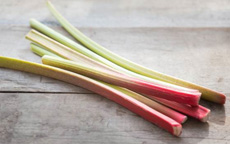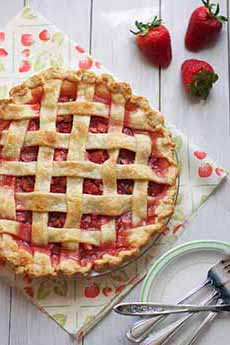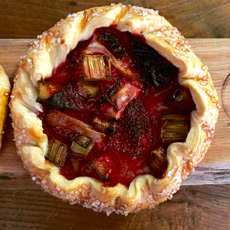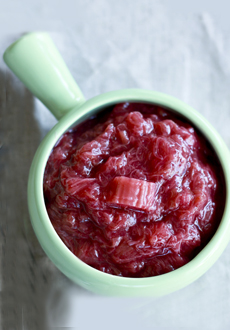Strawberry Rhubarb Galette Recipe, A Spring Favorite Pie
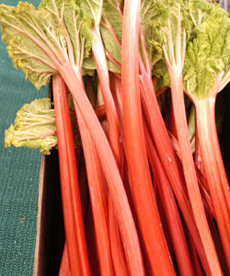 [1] Rhubarb with its leaves. Don’t eat the leaves—they’re mildly toxic (photo © OurOhio.org).
|
To many foodies, the beginning of spring means asparagus, fava beans, morels, ramps, scapes, and shad roe.
We add rhubarb to that list. In North America it grows between April and June, paralleling the asparagus season. Nana was so fond of stewed rhubarb, she made it once or twice a week during rhubarb season. She served it in a dish, like pudding, with or without heavy cream; in a compote; in a parfait; on pound cream (with whipped cream); and as a topping on ice cream. Her daughter, Mom, was an inveterate pie baker, turning out Rhubarb Pie, Raspberry Rhubarb Pie, and Strawberry Rhubarb Pie. There’s a delicious Strawberry Rhubarb Galette (a rustic pie) recipe below. > The history of strawberries. > National Rhubarb Day is January 23rd. > National Strawberry Rhubarb Pie Day is June 9th. Technically, rhubarb is a vegetable, a member of the sorrel family. Fruits are not necessarily sweet. Tomatoes are fruits, avocados are fruits, hot chiles are fruits, and cucumbers and squash are fruits. By botanical definition, fruits have their seeds/pits, on the inside, contained in the fruit’s ovary sac*. Fruits carry their seeds inside; vegetable seeds scatter in the wind. You see seeds in an apple, avocado, cucumber, and tomato, but not in broccoli, carrots, or lettuce. Lacking sweetness doesn’t make it a vegetable. Rhubarb, Rheum rhabarbarum, is a vegetable in the Polygonaceae family. The leaf stalks (petioles) are crisp like celery with a strong, tart taste. Rhubarb looks like rosy-pink celery but is no relation (celery is a member of the Apiaceae family). Even for a vegetable, rhubarb is very tart. Before it was served sweetened, it was added to soups (try it in lentil soup) and sauces: in the Himalayas, in Moroccan tagines, and in Middle Eastern stews. Be sure to cook only the stems; the leaves are mildly toxic (they contain oxalic acid). But for most of us, rhubarb needs a sweetener. It’s absolutely delicious as stewed rhubarb, rhubarb ice cream, rhubarb pie, and its variation in this recipe, strawberry rhubarb pie. Some people eat the stems raw by dipping them into sugar. |
|
|
Rhubarb grew wild in northwest China and was cultivated about 5,000 years ago for medicinal purposes. It made its way west via Turkey and Russia and was first planted in England by an apothecary in 1777. Once sweetened, it became popular for jams, sauces and crumbles. The thinner and darker pink the fresh rhubarb stalks are, the less tart they will be. Look for stalks that are crisp, bright pink, thin, and unblemished. *The only exception is the strawberry, which is not a botanical berry but an accessory fruit. True vegetables have no pit or seed sac. This French-inspired pastry (photo #3) is the perfect balance of tart and sweet, prepared with fresh strawberries and peak season rhubarb enveloped inside a buttery, hand-formed crust and garnished with a touch of sparkling sugar. It’s a spring specialty at Hewn, an artisanal bakery in Evanston, Illinois, which advises that this pastry makes a brief appearance only during the late months of spring when rhubarb season is at its peak. In the pastry world, a galette is a rustic, open-face fruit pie. It is flat, with a flaky, turned-up crust that wraps around the filling to create a “bowl.” The Italian word is crostata. A galette is a pie instead of a tart because it uses a pâte brisée crust, instead of the dense, crumbly, and sweet pâte sablée used for sweet tarts. |
||
|
Ingredients For A 6-Inch Galette
For The Filling Make the Filling 1. CHOP the rhubarb into ¼ inch strips. Toss the rhubarb with the quartered strawberries. 2. ADD the sugar, vanilla bean and sea salt to the rhubarb and strawberries. Toss until it is coated. 3. ADD the flour and mix the filling. |
|
|
|
The easiest way to make the dough is to use a food processor—but you have to make sure to not overwork the dough. 1. USING a food processor add the salt and flour and pulse for 5 seconds. With the food processor on… 2. SLOWLY DROP butter in, in a continuous stream. You should be able to have all the butter added within a minute. Once all the butter is added, let the processor run for 10 more seconds. The dough should look very shaggy and the butter should still be visible. Add the optional herbs. 3. TURN to the the pulse setting and slowly pour the cold water. This is where the dough can get overworked. Once the water is added, the dough will still be shaggy and should NOT form a ball. The shaggier it is, the flakier the dough will be. 4. SCOOP out the dough and form into a flat disk. Wrap with plastic wrap and let the dough chill for 2 hours before rolling it out. 1. PREHEAT the oven to 350°F (325° for a convection oven). 2. ROLL the dough out and use a ring or bowl to trace a round. The size should be about 6 inches. Cover a sheet pan with parchment paper, lay the dough ring on it sheet pan and spoon ¼ cup of the filling in the center. Fold the edges of the dough up, so it creates a pocket to contain the filling. Add the rest of the filling. 3. BRUSH the edge of the dough with the egg wash and bake the galette for 12 minutes. After 12 minutes check: The crust should be deep golden and the filling should not be runny. Founded by partners Ellen King and Julie Matthei in 2013, Hewn is a cozy neighborhood spot in a historic space. Ellen is a classically trained chef, Julie is the business director. Hewn sources local and seasonal ingredients from small, local farmers. The bakery’s name refers to the craftsmanship associated with making something by hand For more information, visit HewnBread.com.
|
||
